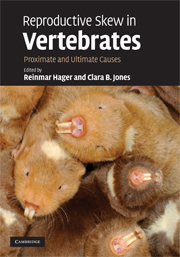Book contents
- Frontmatter
- Contents
- List of contributors
- Foreword
- Preface
- Part I Reproductive skew theory
- Part II Testing assumptions and predictions of skew models
- 3 Reproductive skew in female-dominated mammalian societies
- 4 The effects of heterogeneous regimes on reproductive skew in eutherian mammals
- 5 Social skew as a measure of the costs and benefits of group living in marmots
- 6 Explaining variation in reproductive skew among male langurs: effects of future mating prospects and ecological factors
- 7 The causes and consequences of reproductive skew in male primates
- 8 Sociality and reproductive skew in horses and zebras
- 9 Reproductive skew in avian societies
- 10 Reproductive skew in cooperative fish groups: virtue and limitations of alternative modeling approaches
- 11 Reproductive skew in primitively eusocial wasps: how useful are current models?
- Part III Resolving reproductive conflicts: behavioral and physiological mechanisms
- Part IV Future directions
- Taxonomic index
- Subject index
10 - Reproductive skew in cooperative fish groups: virtue and limitations of alternative modeling approaches
from Part II - Testing assumptions and predictions of skew models
Published online by Cambridge University Press: 02 February 2010
- Frontmatter
- Contents
- List of contributors
- Foreword
- Preface
- Part I Reproductive skew theory
- Part II Testing assumptions and predictions of skew models
- 3 Reproductive skew in female-dominated mammalian societies
- 4 The effects of heterogeneous regimes on reproductive skew in eutherian mammals
- 5 Social skew as a measure of the costs and benefits of group living in marmots
- 6 Explaining variation in reproductive skew among male langurs: effects of future mating prospects and ecological factors
- 7 The causes and consequences of reproductive skew in male primates
- 8 Sociality and reproductive skew in horses and zebras
- 9 Reproductive skew in avian societies
- 10 Reproductive skew in cooperative fish groups: virtue and limitations of alternative modeling approaches
- 11 Reproductive skew in primitively eusocial wasps: how useful are current models?
- Part III Resolving reproductive conflicts: behavioral and physiological mechanisms
- Part IV Future directions
- Taxonomic index
- Subject index
Summary
Summary
Four types of cooperation between conspecific competitors can be differentiated in fish reproduction: joint defense of a spawning site or territory, joint preparations for spawning, cooperative spawning, and cooperative brood care. Long-lasting associations allowing for different reproductive shares of partners are mainly found in species that cooperate in territory defense and brood care. Here I use skew theory to scrutinize patterns of reproductive participation among related and unrelated group members in cooperatively reproducing cichlids and wrasses. A comparison of five species from which sufficient data are available does not reveal an obvious relationship between average relatedness, or group size, and reproductive skew levels, as predicted from respective skew models. It is remarkable that superficially similar cooperative systems in fish may be based on distinctly different parameter combinations, even in closely related species. I discuss five alternative schemes to understand the patterns of reproductive participation in cooperatively reproducing fish, including kin-selection theory, reciprocity models, manipulation or coercive strategies, models of alternative reproductive tactics, and a dynamic modeling approach. A comparison of approaches suggests that conventional skew models do not account for the complexity of evolutionary mechanisms involved in reproductive skew among members of fish groups. Alternative approaches, such as reciprocity theory or models to explain the coexistence of alternative reproductive tactics, may have greater explanatory potential, at least in some cases. However, they have generally not been developed sufficiently to derive predictions allowing for a conclusive test. To understand how decisions of distinctly different types of group members evolve, an approach is needed that takes account of the state dynamics involved, as in fish, conditions constantly change due to their continued growth after maturation.
Information
- Type
- Chapter
- Information
- Reproductive Skew in VertebratesProximate and Ultimate Causes, pp. 265 - 304Publisher: Cambridge University PressPrint publication year: 2009
Accessibility standard: Unknown
- 18
- Cited by
